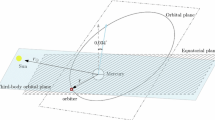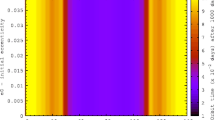Abstract
Let us consider the restricted three-body problem. Analysis of the orbital motion of a spacecraft around planets or moons is presented taking into account the nonsphericity of the primaries and the perturbations coming from a third body in an elliptical and inclined orbit. In the specific case of a spacecraft designed to explore a planet, moon or asteroid, it is noteworthy the increasing use of the averaging methods. This is a very powerful technique to simulate, very fast, the main effects caused by the disturbers on the dynamics of the spacecraft. In this work, we focus on the averaged methods applied in different conditions. Some comparisons are presented between the single-averaged, double-averaged models and the complete model, that is, the unaveraged model based on direct integration of the Cartesian (x, y, z) coordinates. This unaveraged model is quite necessary as it provides all the requirements to validate the performance and evaluate the usefulness of the averaged models for each specific problem. In the first part of this paper, we describe briefly some well-known techniques to obtain the averaged model considering the nonsphericity of the primary as well as the perturbation due to the third body. On the other hand, this is a opportunity to mention some misprints and typos problems, in the literature related to this subject. We compared the performance of single- and double-averaging models, keeping the x–y–z unaveraged model as the baseline of reference. The case of a high lunar orbit (Nie et al. in Celest Mech Dyn Astron 131(29):1–31, 2019) considering the perturbation of the Earth seems to be instructive. Single-average model is more accurate than the double-average model in the analysis of the eccentricity evolution, but in some cases of the inclination evolution, the three models agree and the average models are both very accurate. When comparing the results, eventual typos were detected in some works related to the literature of this subject. In the second part of this paper, we detached some aspects of the dynamics of a probe around Mercury (Sect. 5) involved in frozen orbit (FO) and in "quasi-frozen orbit", (quasi-FO). Due to the interesting gravitational field of the planet and its proximity to the Sun, this is an important problem. Recently, many papers, not only on pure dynamics but on gravitational field of Mercury, have been published, according to references listed in this work. An exhaustive investigation on FO using double-averaging model was reported in Tresaco et al. (Celest Mech Dyn Astron 130(9):1–26, 2018). In this paper we revisit this problem, using x–y–z-model as a primary source of results. After a number of experiments, it was possible to use confidently the single averaging in many cases, for instance, in searching "quasi-FO" for Mercury planet. Although we do not include the effect of the radiation pressure, a number of our simulations can be compared with those given in Tresaco et al. (2018).




















Similar content being viewed by others
References
Abad, A., Elipe, A., Tresaco, E.: Analytical model to find frozen orbits for a lunar orbiter. J. Guid. Control. Dyn. 32(3), 888–898 (2009)
Broucke, R.A.: Long-term third-body effects via double averaging. J. Guid. Control. Dyn. 26(1), 27–32 (2003)
Brouwer, D., Clemence, G.M.: Methods of Celestial Mechanics, p. 595. Academic Press, New York (1961)
Carbone, A., Cinelli, M., Circi, C., Ortores, E.: Observing Mercury by quasi-propellantless mission. Celest. Mech. Dyn. Astron. 132(8), 1–14 (2020)
Cardoso dos Santos, J., Carvalho, J.P.S., Prado, A.F.B.A., Vilhena de Moraes, R.: Lifetime maps for orbits around Callisto using a double-averaged model. Astrophys. Space Sci. 362(227), 1–18 (2017)
Carvalho, J.P.S., Vilhena de Moraes, R., Prado, A.F.B.A.: Analysis of the orbital evolution of space debris using a solar sail and natural forces. Adv. Space Res. 70(1), 125–143 (2022)
Carvalho, J.P.S., de Moraes, R.V.: A semi-analytical approach using the single and double averaged methods and the Lidov–Kozai mechanism. Eur. Phys. J. Sp. Top. 229(8), 1491–1500 (2020)
Carvalho, J.P.S., Cardoso dos Santos, J., Prado, A.F.B.A., Vilhena de Moraes, R.: Some characteristics of orbits for a spacecraft around Mercury. Comput. Appl. Math. 37, 267–281 (2018)
Carvalho, J.P.S., Vilhena de Moraes, R., Prado, A.F.B.A.: Some orbital characteristics of lunar artificial satellites. Celest. Mech. Dyn. Astron. 108, 371–388 (2010)
Celletti, A., Galeş, C., Pucacco, G., Rosengren, A.J.: Analytical development of the lunisolar disturbing function and the critical inclination secular resonance. Celest. Mech. Dyn. Astron. 127, 259–283 (2017)
Chambers, J.E.A.: Hybrid symplectic integrator that permits close encounters between massive bodies. Mon. Not. R. Astron. Soc. 304, 793–799 (1999)
Cinelli, M., Ortore, E., Circi, C.: Long lifetime orbits for the observation of Europa. J. Guid. Control. Dyn. 42(1), 123–135 (2019)
Elipe, A., Lara, M.: Frozen orbits about the Moon. J. Guid. Control. Dyn. 26(2), 238–243 (2003)
Delsate, N., Robutel, P., Lemaître, A., Carletti, T.: Frozen orbits at high eccentricity and inclination: application to Mercury orbiter. Celest. Mech. Dyn. Astron. 108, 275–300 (2010)
Giacaglia, G.E.O., Murphy, J., Felsentreger, T.: A semi-analytic theory for the motion of a lunar satellite. Celest. Mech. 3, 3–66 (1970)
Giuppone, C.A., Roig, F., Saad-Olivera, X.: Modeling the evection resonance for Trojan satellites: application to the Saturn system. Astron. Astrophys. 620(A90), 1–13 (2018)
Konopliv, A.S., Park, R.S., Ermakov, A.I.: The Mercury gravity field, orientation, love number, and ephemeris from the MESSENGER radiometric tracking data. Icarus 335(1), 113386 (2020)
Kozai, Y.: Secular perturbations of asteroids with high inclination and eccentricity. Astron. J. 67(9), 591–598 (1962)
Lara, M., Palacián, J.F., Yanguas, P., Corral, C.: Analytical theory for spacecraft motion about Mercury. Acta Astronaut. 66(7–8), 1022–1038 (2010)
Lidov, M.L.: The evolution of orbits of artificial satellites of planets under the action of gravitational perturbations of external bodies. Planet. Space Sci. 9(10), 719–759 (1962)
Ma, X., Li, J.: Artificial frozen orbits around Mercury. Astrophys. Space Sci. 348, 345–365 (2013)
Mazarico, E., Genova, A., Goossens, S., et al.: The gravity field, orientation, and ephemeris of Mercury from MESSENGER observations after three years in orbit. J. Geophys. Res. Planets 119(12), 2417–2436 (2014)
Montenbruck, O., Gill, E., Mahooti, M.: Satellite Orbits Models Methods Applications, 1st edn. Springer, Berlin (2000)
Murray, C.D., Dermott, S.F.: Solar System Dynamics, p. 592. Cambridge University Press, Cambridge (1999)
Nie, T., Gurfil, P., Zhang, S.: Semi-analytical model for third-body perturbations including the inclination and eccentricity of the perturbing body. Celest. Mech. Dyn. Astron. 131(29), 1–31 (2019)
Nie, T., Gurfil, P.: Lunar frozen orbits revisited. Celest. Mech. Dyn. Astron. 130(61), 1–35 (2018)
Prado, A.F.B.A.: Third-body perturbation in orbits around natural satellites. J. Guid. Control. Dyn. 26(1), 33–40 (2003)
Scheeres, D.J., Ostrob, S.J., Hudsonc, R.S., DeJongb, E.M., Suzukib, S.: Dynamics of orbits close to asteroid 4179 Toutatis. Icarus 132(1), 53–79 (1998)
Stuchi, T.J., et al.: Dynamics of a spacecraft and normalization around Lagrangian points in the Neptune-Triton system. Adv. Space Res. 42(10), 715–1722 (2008)
Thibes, M.L.G., Vilhena de Moraes, R., Prado, A.F.B.A., Carvalho, J.P.S.: An optimization approach to search for quasi-critical inclinations for direct and retrograde orbits. Eur. Phys. J. Sp. Top. 229, 1429–1440 (2020)
Thibes, M.L.G., Vilhena de Moraes, R., Prado, A.F.B.A., Carvalho, J.P.S.: Quasi-heliosynchronous orbits. Adv. Astronaut. Sci. 171, 2307–2322 (2020)
Tresaco, E., Carvalho, J.P.S., Elipe, A., Prado, A.F.B.A., Vilhena de Moraes, R.: Celest. Mech. Dyn. Astron. 130(9), 1–26 (2018)
Tresaco, E., Elipe, A., Carvalho, J.P.S.: Frozen orbits for a solar sail around Mercury. J. Guid. Control Dyn. 39(7), 1659–1666 (2016)
Verma, A.K., Margot, J.L., Geophys, J.: Mercury’s gravity, tides, and spin from MESSENGER radio science data. Res. Planets 121(9), 1627–1640 (2016)
Yokoyama, T.: Dynamics of some fictitious satellites of Venus and Mars. Planet. Space Sci. 47(5), 619–627 (1999)
Yokoyama, T.: Possible effects of secular resonances in Phobos and Triton. Planet. Space Sci. 50(1), 63–77 (2002)
Yokoyama, T., Santos, M.T., Gardin, G., Winter, O.C.: On the orbits of the outer satellites of Jupiter. Astron. Astrophys. 401(2), 763–772 (2003)
Yokoyama, T., Vieira Neto, E., Winter, O.C., Sanchez, D.M., Brasil, P.I.O.: On the evection resonance and its connection to the stability of outer satellites. Math. Problems Eng. 2008, 1–16 (2008). https://doi.org/10.1155/2008/251978
Acknowledgements
The authors are grateful to CNPq (National Council for Scientific and Technological Development) - Brazil for contracts 307724/2017-4, 420674/2016-0 and FAPESP (process 2016/24561-0) for the financial support.
Author information
Authors and Affiliations
Corresponding author
Ethics declarations
Conflict of interest
The authors declare that they have no conflict of interest.
Additional information
Publisher's Note
Springer Nature remains neutral with regard to jurisdictional claims in published maps and institutional affiliations.
Appendices
Appendix A
To apply the average, we use known equations of the celestial mechanics, which are:
where l is the mean anomaly of the space vehicle.
Now replacing Eqs. (3), (19), (20) and (21) in Eq. (2), the average is made using Eq. (22).
For the mean anomaly (\(l_{\odot }\)) of the third body to appear explicitly in Eq. (4), we use the following expansions given by Eqs. (23), (24) and (25) (see Murray and Dermott 1999).
The well-known formulas of the two-body problem connecting true and mean anomaly (Brouwer and Clemence 1961) is used:
Appendix B
The disturbing potential due to the third body in an elliptical and inclined orbit, obtained via the single-averaged model, is written in the form
where \(c_{\odot }=\cos (i_{\odot })\) and \(s_{\odot }=\sin (i_{\odot })\).
Appendix C
Now, a second average is applied to obtain the double-averaged disturbing potential in elliptical and inclined orbit, to eliminate the short-period terms of the disturbing body. For this, it is necessary to perform algebraic manipulations where we used known equations of celestial mechanics (see Brouwer and Clemence 1961), namely Eqs. (28) and (29).
Using Eqs. (4), (28) and (29), after some algebraic manipulations, we get
From Brouwer and Clemence (1961), we know that in the double-averaged process the pericenter argument of the third body is eliminated from the disturbing potential, see, for example, a recent demonstration of this fact given by Yokoyama (1999) and Celletti et al. (2017). Now, making \(i_{\odot }= 0\), \(e_{\odot }=0\) in Eq. (30), we obtain the double-averaged equation in planar and circular orbit. After algebraic manipulations, we check that the simplified equation is in agreement with Nie et al. (2019) (equation 67), Yokoyama (2002) and Broucke (2003).
Rights and permissions
About this article
Cite this article
Carvalho, J.P.S., Yokoyama, T. & Mourão, D.C. Single-averaged model for analysis of frozen orbits around planets and moons. Celest Mech Dyn Astron 134, 35 (2022). https://doi.org/10.1007/s10569-022-10092-6
Received:
Revised:
Accepted:
Published:
DOI: https://doi.org/10.1007/s10569-022-10092-6




